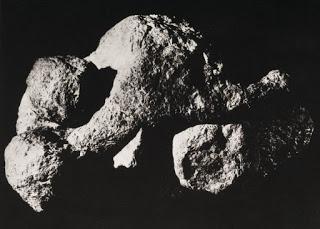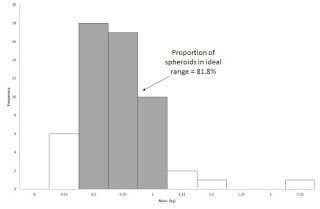Figure 1. Spheroids
The paper is an affordance analysis of some prehistoric objects (spherical rocks called 'spheroids') that were excavated from a cave in South Africa. There are several theories about what the prehistoric humans used these for, but one is that they were projectiles used for hunting. I created a simulation of projectile motion and set the parameters of the simulation using data from the literature on throwing for maximum distance. We then showed that a majority of our sample spheroids were ideally suited for throwing to inflict useful damage to a medium sized prey animal over fairly long distances. Given that we know humans have been anatomically specialising for throwing for millions of years, and given that we know modern humans can perceive the affordance for throwing to a maximum distance and select objects that best fit this affordance, we argue that these simulations provide evidence that these objects were selected to be used as projectiles.This slightly out-of-left-field project was the result of some good luck, some careful management and the hard work of all my collaborators as we tied this together. The paper stands as an exemplar and proof-of-concept of how a task-dynamical affordance analysis can tell us about the behavior of prehistoric humans.
How the collaboration happenedI got invited to speak at the University of Liverpool in 2014, and I took my (now published) throwing data along. I just so happened to throw a line into the abstract that throwing is interesting because of the role it has played in our evolutionary history. This caught the eye of Larry Barham and Ian Stanistreet, two archaeologists interested in this topic. I presented my affordance analysis and data, and they asked me 'if you had some information about prehistoric objects, could you apply this analysis to learn anything interesting?'. I thought about it and said 'yes'.
We stayed in touch, threw some ideas around, and then Larry and Ian pulled some spheroid data from several different digs. After some thought, we targeted our first collaboration on a proof-of-concept piece; we would ask whether a set of objects from one site (the Cave of Hearths in South Africa) made useful projectiles for hunting. Then I started assembling the pieces.
SpheroidsSpheroids are round rocks that are created by natural weathering of rocks made of diabase. As these rocks roll down rivers, they wear down into objects of varying sizes, weights and roundness. The spheroids at the Cave of Hearths come from a rock deposit a couple of kilometers away, so they were definitely selected and transported by the cave inhabitants, not just randomly dumped there. Our sample was 55 rocks that were suitably spherical (this simplifies the simulations and allows us to rely on data from throwing spherical objects). Future work will expand the simulations to handle the complexities introduced by non-symmetrical projectiles.
Simulations
I adapted some software from my co-authors Zhu and Bingham to simulate the flight of each spheroid under various conditions. Their previous work on throwing for maximum distance had established an empirical relations between object mass and release velocity that I could use to set up the simulations. In effect, I was able to figure out what kind of trajectories these spheroids would take if thrown by a skilled human. This meant I could estimate the maximum distance they'd travel, the speed they'd be going at impact, etc, all of which I needed to see if they'd be useful for hunting.
Damage
For these things to be useful, a human would have to be able to throw them and inflict worthwhile damage on a prey animal. After computing some rough numbers based on impact speed, I sat down and spent the afternoon on Google Scholar. I finally stumbled across the (slightly creepy) world of forensic analysis of impact damage. I say creepy because a lot of the work involves firing projectiles at anesthetized pigs and seeing what happens. The goal of this work, though, is to develop mathematical models that you can then use to figure out questions about ballistics and impact trauma in forensic cases, car crashes etc without having to shoot any more pigs, and it's these models I was able to use in a fully pig-free manner.
The big break through came when I finally tracked David Viano down by email. Viano is responsible for inventing many of the key models in this field and he gave me some wonderful advice on implementing the best measure. The key paper he sent me was Sturdivan, Viano & Champion (2003) in which they developed the Blunt Criterion. This model is a ratio of the energy imparted by the projectile on impact divided by the ability of the target to absorb that energy (thanks to John Hutchinson and a friend of his, Brandon Kilbourne for some useful biomechanics data for working out the latter). I was able to figure out values for all the terms from my simulations and the empirical work reported in Sturdivan et al and compute the BC for all the spheroids impacting at various fractions of maximum distance.
The final critical piece also came from Sturdivan et al, which did one final amazingly useful thing. They regressed their Blunt Criterion measure against a measure of the damage from impacts, the Abbreviated Injury Scale. An AIS 1 injury is merely a scratch; 3 is fairly serious (e.g. an open fracture of the humerous) and 6 means you're dead and you aren't getting up again. The regression yielded an equation that allowed me to predict the probability of an injury at each AIS level, given the Blunt Criterion.
The End ResultFigure 2. The probability of various levels of injury from all 55 spheroids sorted by mass
The first result was that most of the spheroids stood a good chance of at least breaking a bone. None of them could kill the animal (here an impala, sort of a worst case scenario for inflicting damage) but a few impacts would cause serious havoc and simplify the followup persistence hunting. This graph is for impacts at maximum distance, by the way, which was around 25m for these objects.There's a sweet spot centred around a mass of .75kg where extra mass stops increasing the probability of damage but continues to make the object harder to throw. The second result was that 82% of the spheroids had masses in this sweet spot (Figure 3)
Figure 3. The mass distribution of the spheroids with the sweet spot marked in grey
Not all the objects are optimal, but this (we believe) reflects the fact that they are being selected, not made. The riverbed where these come from contains a wide range of rocks and optimal objects may simply not be present. We do know that humans can perceive relative optimality for throwing, though (Zhu, Mirich & Bingham, 2014) and so this mass distribution is evidence that the selection of objects was being guided by the affordances for throwing they offered. SummaryI have loved every minute of this project. I did all the work for this paper at my desk with Matlab and the internet. I had a question and a series of numbers to try and use, and got to just play until I figured out the answer (just like the xkcd-What If comic, although I did not use his suggested giraffe units for this project; maybe next time!). My co-authors were all great; we divided and conquered various elements (Larry and Ian handled all the archaeological questions, Geoff, Arthur and I handled the affordance and simulation questions and I coordinated the whole thing) and it was a genuine pleasure to invent something truly new with them. In fact, this project is the model I have in mind when I think about new collaborations now. I'm looking forward to taking this project forward in the very near future.
I'm also pretty pleased we got this into Scientific Reports. It's a slightly glam-mag choice, but I want it to make a splash, I wanted it open access (thanks to my Faculty for paying the bill!) and I am properly excited to get this project into a shiny journal where it might get seen by a broad readership. I'm deeply proud that we got great reviews from two reviewers who clearly read the paper carefully. I really appreciated their attention and the pay-off for all the sweat that went into crafting this paper.
But mostly, this project became near to my heart because I did it just for the fun of it. There's serious science here, but at the end of the day I got to play in Matlab and invent a novel analysis framework to answer a question about some goddamn prehistoric rocks just because someone at a talk I gave asked me if I could do it. How goddamn amazing is that?? We all spend so much time sweating about impact and the REF and grants and this project was not motivated by any of this. It's what I thought science would always be like, and it was nice to be reminded that I can do this kind of work, have fun, and hit those other concerns just as side effects. More science like this for me, I think!
ReferencesWilson, A. D. et al. A Dynamical Analysis of the Suitability of Prehistoric Spheroids from the Cave of Hearths as Thrown Projectiles. Sci. Rep. 6, 30614; doi: 10.1038/srep30614 (2016)
Media Coverage (mostly for my own reference!)
Daily Mail Irish Times



